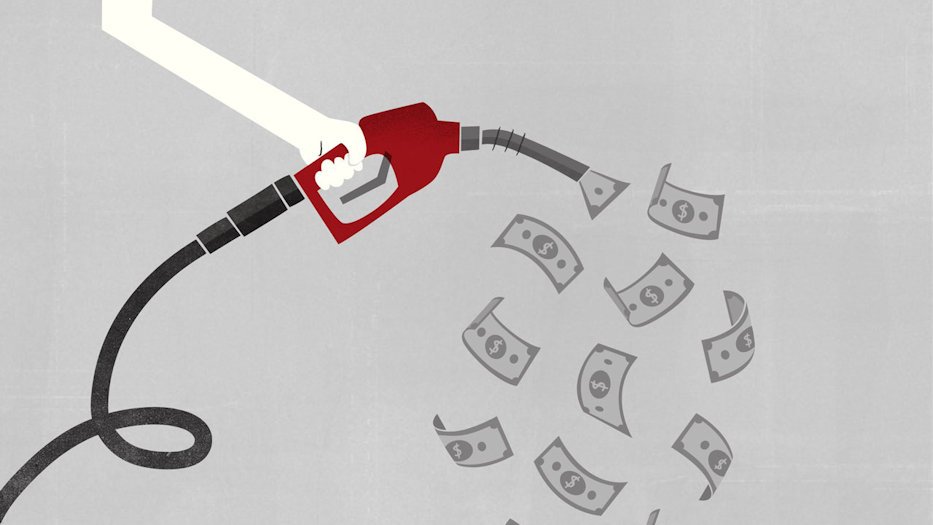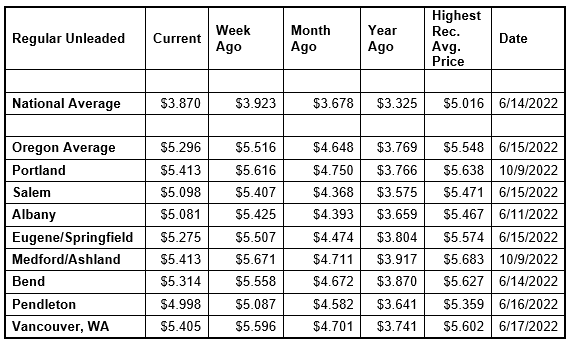AAA: Oregon gas prices down 22 cents a gallon in past week, second-biggest drop in U.S.

(Update: AAA Oregon/Idaho weekly report)
PORTLAND, Ore. (KTVZ) – Oregon and other West Coast states are seeing some of the biggest weekly gas-price decreases in the nation, AAA Oregon/Idaho reported Tuesday.
Gasoline supplies in the area are returning to normal as regional refinery issues are resolved. they said. In addition, falling crude oil prices and demand for gas in the U.S. are also helping to push pump prices lower.
For the week, the national average for regular loses five cents to $3.87 a gallon. The Oregon average plummets 22 cents to $5.30. This is the second-largest weekly drop for a state in the nation.

The Oregon average came within a penny of reaching a new record high this month, when it got to $5.54 a gallon. It has decreased 24 cents since then. Both the national and Oregon averages hit record highs in mid-June, then declined for 14 consecutive weeks before rising again for the last three weeks. The national average reached its record high of $5.016 on June 14 while the Oregon average reached its record high of $5.548 on June 15.
“Pump prices on the West Coast soared last month after several California refineries underwent planned or unplanned maintenance creating a huge drop in supplies in this region. The situation is getting back to normal and pump prices in this region should continue to decline, barring unforeseen events,” says Marie Dodds, public affairs director for AAA Oregon/Idaho.
Crude oil prices are again below $90 per barrel due to global economic concerns. Crude reached a recent high of $122.11 per barrel on June 8, and ranged from about $94 to $110 per barrel in July. In August, crude prices ranged between about $86 and $97. In September, crude prices ranged between about $76 and $88 per barrel. So far in October, crude has ranged between $81 and $93 per barrel.
Crude prices rose dramatically leading up to and in the first few months of Russia’s invasion of Ukraine. Russia is one of the world’s top oil producers and its involvement in a war causes market volatility, and sanctions imposed on Russia by the U.S. and other western nations resulted in tighter global oil supplies. Oil supplies were already tight around the world as demand for oil increased as pandemic restrictions eased. A year ago, crude was around $82 per barrel compared to $83 today.
Crude oil is the main ingredient in gasoline and diesel, so pump prices are impacted by crude prices on the global markets. On average, about 53% of what we pay for in a gallon of gasoline is for the price of crude oil, 12% is refining, 21% distribution and marketing, and 15% are taxes, according to the U.S. Energy Information Administration.
Demand for gasoline in the U.S. decreased from 9.47 million b/d to 8.28 million b/d for the week ending October 7. This is significantly less than a year ago at this time when demand was 9.2 million b/d. Total domestic gasoline stocks increased by 2 million bbl to 209.5 million bbl. Falling demand and increasing stocks should put downward pressure on pump prices, especially with decreasing crude oil prices.
Quick stats
Oregon is one of 32 states with lower prices now than a week ago. California (-29 cents) has the largest weekly drop in the nation. Oregon (-22 cents) has the second-largest week-over-week decline. Florida (+6 cents) has the largest weekly increase.
California ($6.00) has the most expensive gas in the country for the sixth week in a row and is the only state with an average at or above $6 a gallon. Six states, including Oregon, have averages at or above $5 a gallon. This week 13 states have averages at or above $4, and 37 states and the District of Columbia have averages in the $3-range.
The cheapest gas in the nation is in Georgia ($3.25) and Texas ($3.29). For the 93rd week in a row, no state has an average below $2 a gallon.
The difference between the most expensive and least expensive states is $2.75 which is stark.
Oregon is one of 40 states with higher prices now than a month ago. The national average is 19 cents more and the Oregon average is 65 cents more than a month ago. Oregon has the second-largest monthly increase in the nation. Alaska (+75 cents) has the largest month-over-month jump. New York (-11 cents) has the largest monthly drop.
All 50 states and the District of Columbia have higher prices now than a year ago. The national average is 55 cents more and the Oregon average is $1.53 more than a year ago. This is the second-largest yearly increase in the nation. Alaska (+$1.70) has the biggest yearly increase. Connecticut (+8 cents) has the smallest year-over-year increase.
West Coast
The West Coast region continues to have the most expensive pump prices in the nation with all seven states in the top 10. This is typical for the West Coast as this region tends to consistently have fairly tight supplies, consuming about as much gasoline as is produced. In addition, this region is located relatively far from parts of the country where oil drilling, production and refining occurs, so transportation costs are higher. And environmental programs in this region add to the cost of production, storage and distribution.
Refinery issues in California in September and earlier this month exacerbated the situation, creating extremely tight supplies and causing pump prices in this region to soar.
| Rank | Region | Price on 10/18/22 | ||
| 1 | California | $6.00 | ||
| 2 | Alaska | $5.40 | ||
| 3 | Oregon | $5.30 | ||
| 4 | Nevada | $5.23 | ||
| 5 | Hawaii | $5.23 | ||
| 6 | Washington | $5.22 | ||
| 7 | Arizona | $4.46 | ||
| 8 | Idaho | $4.40 | ||
| 9 | Illinois | $4.32 | ||
| 10 | Utah | $4.23 |
As mentioned above, California is the most expensive state for the sixth consecutive week with Alaska, Oregon, Nevada, Hawaii, Washington, and Arizona rounding out the top seven. Oregon is third most expensive for the fourth consecutive week.
All seven states in the region are seeing some of the largest declines in the country: California (-29 cents), and Oregon (-22 cents) have the largest weekly drops in the nation. Washington (-17 cents) has the fourth-largest weekly drop. Nevada (-17 cents) has the fifth-largest; Alaska (-14 cents) has the seventh-largest, and Arizona (-11 cents) has the 10th-largest weekly decline.
The refinery utilization rate on the West Coast fell from 83.3% to 80.1% for the week ending October 7. The rate has ranged between about 76% and 90% in the last year.
According to EIA’s latest weekly report, total gas stocks in the region increased from 24.68 million bbl.to 24.80 million bbl.
Oil market dynamics
Crude prices decreased last week as global economic fears pulled crude prices lower. For this week, crude prices could continue to weaken as interest rates rise globally, which could lead to an economic slowdown or recession. If a recession occurs, crude prices would likely fall alongside demand. Additionally, EIA’s latest weekly report showed that total commercial crude inventories increased by 9.9 million bbl to 439.1 million bbl.
At the close of Friday’s formal trading session, WTI decreased by $3.50 to settle at $85.61. At the close of Monday’s formal trading session, WTI slipped 15 cents to close at $85.46. Today crude is trading around $83, compared to $89 a week ago. Crude prices are about $1 more than a year ago.
Drivers can find current gas prices along their route with the free AAA Mobile app for iPhone, iPad and Android. The app can also be used to map a route, find discounts, book a hotel and access AAA roadside assistance. Learn more at AAA.com/mobile.
--
CHICAGO (KTVZ) -- Average gasoline prices in Oregon have fallen 19.4 cents per gallon in the last week, averaging $5.30/g Monday, according to GasBuddy's survey of 1,307 stations in Oregon. Still, prices in Oregon are 66.5 cents per gallon higher than a month ago and stand $1.57/g higher than a year ago.
The national average price of diesel, meanwhile, has increased 18.7 cents in the last week and stands at $5.06 per gallon.
According to GasBuddy price reports, the cheapest station in Oregon was priced at $4.05/g Sunday while the most expensive was $6.29/g, a difference of $2.24/g. The lowest price in the state Sunday was $4.05/g while the highest was $6.29/g, a difference of $2.24/g.
The national average price of gasoline has fallen 5.4 cents per gallon in the last week, averaging $3.86/g Monday. The national average is up 20.6 cents per gallon from a month ago and stands 56.6 cents per gallon higher than a year ago, according to GasBuddy data compiled from more than 11 million weekly price reports covering over 150,000 gas stations across the country.
Historical gasoline prices in Oregon and the national average going back ten years:
October 17, 2021: $3.74/g (U.S. Average: $3.30/g)
October 17, 2020: $2.55/g (U.S. Average: $2.16/g)
October 17, 2019: $3.29/g (U.S. Average: $2.67/g)
October 17, 2018: $3.35/g (U.S. Average: $2.86/g)
October 17, 2017: $2.74/g (U.S. Average: $2.45/g)
October 17, 2016: $2.52/g (U.S. Average: $2.23/g)
October 17, 2015: $2.35/g (U.S. Average: $2.26/g)
October 17, 2014: $3.42/g (U.S. Average: $3.13/g)
October 17, 2013: $3.52/g (U.S. Average: $3.35/g)
October 17, 2012: $4.05/g (U.S. Average: $3.75/g)
Metro areas and their current gas prices:
Eugene- $5.34/g, down 17.8 cents per gallon from last week's $5.52/g.
Salem- $5.14/g, down 24.6 cents per gallon from last week's $5.38/g.
Portland- $5.42/g, down 20.7 cents per gallon from last week's $5.62/g.
"After a sharp rise in the national average over the last few weeks, we've seen an abrupt, yet expected decline as refinery issues have eased in the West and Great Lakes, overpowering some increases elsewhere. Though at the same time, diesel prices have soared," said Patrick De Haan, head of petroleum analysis at GasBuddy.
"We'll see a continued sharp drop in gas prices on the West Coast, including areas like Las Vegas and Phoenix, which are supplied by refiners in California, as refinery outages have been addressed.
"The Great Lakes will see prices drift lower as BP's Whiting refinery is soon to complete maintenance. In addition, oil prices have cooled off slightly after OPEC+'s decision to cut production, and that should slow increases elsewhere. Diesel and heating oil prices are likely to continue to rise, as extremely low inventories of middle of the barrel products like these two push prices higher."
GasBuddy calls itself the authoritative voice for gas prices and the only source for station-level data. GasBuddy's survey updates 288 times every day from the most diverse list of sources covering nearly 150,000 stations nationwide, the most comprehensive and up-to-date in the country. GasBuddy data is accessible at http://prices.GasBuddy.com.
GasBuddy also fuels KTVZ.COM's Pump Patrol, showing the lowest reported gas prices on the High Desert.



